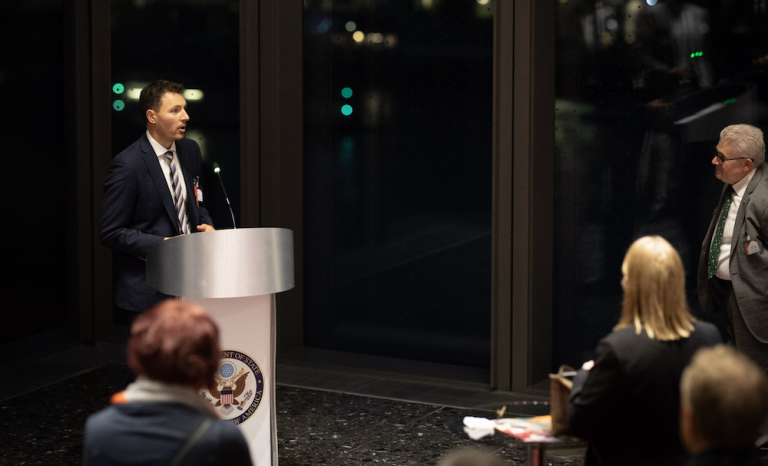Last week, 21 higher education leaders braved torrential rain and train strikes to discuss lifelong learning with the team at Instructure.
We opened the session at the US embassy with a short presentation from revered higher education expert Professor Martin Bean CBE about global education trends and what industries require from today’s workforce. Afterwards, Stephan Fortier, Regional Vice President at Instructure shared a view of the situation in the UK backed with independent survey data from 2023. Led by Prof Bean, the group then broke out into roundtable discussions for the following 75 minutes. Here were some of the key takeaways:
Is your institution strategically focused on serving lifelong learners? If yes, what is your primary motivation? If not, why not?
For some institutions, lifelong learning is core to their DNA. Their motivations are, and always have been, giving learners an alternative route to education.
It was clear that several universities are becoming more strategically focused on serving lifelong learners to deliver relevant, industry-needed education in a new age of learning and upskilling. The discussion reflected a response to the growing climate of learning how versus learning about. Some participants voiced that, if executed wisely, bitesized lifelong learning opportunities such as microcredentials, can help institutions diversify their streams of income and act as an on-ramp to other programmes such as PG Cert, PGDip or Degrees.
Participants highlighted the current skills crisis in the UK, and the need to meet the skills gaps within their regions at the request of organisations such as local authority government or NHS trusts. They also talked about the role of industry in co-creating a course that an employer deems necessary, and how this approach creates instant learner demand for that course.
Several participants grappled with finding the time and resources required to create new offerings and reinvent legacy systems and processes. Others shared the difficulty of competing with challenger institutions who have always made lifelong learning their bread and butter and chose to focus on doing what they do best.
Many core university offerings, such as taught degree programmes, are currently measured by the Research Excellence Framework and Teaching Excellence Framework and are important to attracting students domestically and internationally. Shifting strategic focus away from those core offerings understandably wasn’t top of mind for these institutions. However, most have launched at least a few courses to benefit from an additional revenue stream, usually with a content partner or MOOC provider.
Is your institution currently offering, or contemplating offering microcredentials? If yes, what has worked well and what challenges have you experienced? If not, why not?
Participants had varying definitions of microcredentials, but their questions were similar: Are they credit-bearing? How many credits is each credential worth? Are they stackable, awarded as a single achievement or both? Can they sit within a degree programme? Putting definitions and questions aside, for many of the universities in the room, there was an appetite to offer some form of bitesized learning opportunity.
One university shared that their student union was explicitly asking for microcredentials, and some said the demand was coming from regional businesses.
Another institution shared that they offer about 40 microcredentials and non-accredited short courses. Others had dipped their toes in the pool of bitesized learning opportunities, with one Russell Group university offering 10 credit lifelong learning modules. Most institutions had at least piloted short courses or individual modules as options or were exploring offering digital badges to accredit or gamify the learning. Some universities also offered bitesized learning opportunities for adult learners to supplement their traditional degrees, or at a discounted rate for alumni.
A couple of institutions said they'd seen success when encouraging learners to focus on the outcome of the learning pathway and not the individual unit. This idea of stackability came up in a few discussions because, for learners, there was a desire to take several microcredentials and build them up over time and work towards a higher qualification.
For those not offering microcredentials - their qualms were with the currency of microcredentials, and whether they held much value for learners. Others countered this with the point that microcredentials require collaboration with industry to create a qualification aligned with a “need” in the job market - that's where the value comes in.
Similar to the idea of “lifelong learning” as a whole, some participants expressed concern over getting a return on investment in an increasingly saturated market for microcredentials where it is hard to carve out a niche.
Is your institution technologically prepared for a shift towards new student types and new credentials? If not, what digital enhancements need to be made?
One institution had recently launched a completely separate and new “online” offering. They were quite passionate that legacy systems couldn't support new student types or credentials. However, the conversation shouldn’t start with the technology, but rather the pedagogy and learning outcomes. Once you get these right, you can implement a digital learning ecosystem that supports your pedagogical vision.
Following discussion around quality online/blended teaching, the conversation shifted to Student Record Systems that could not support different enrolment types or credit awards, and the necessity for purpose-built CRMs.
Many roundtable participants agreed that “new student types” could include mature learners, part-time workers, carers and generally people who need to learn remotely and at their own pace. In these scenarios, it’s key to have robust virtual learning environments that support diverse needs.
Some institutions had already successfully rolled out such environments and accommodated these new student types. For others, the challenge is making trade-offs, and deciding which priorities can be dropped in favour of digital enhancements. Several roundtable participants pointed out that to innovate in this way, you need an agile, rapid adoption, fail-fast mindset - words that aren't typically synonymous with the Higher Education sector.
When discussing the technology required for new credentials, a few participants voiced concern about finding technology that supports the mechanics, for instance, storing digital badges, stacking microcredentials or transferring these qualifications between institutions.
As others pointed out, however, the technology for managing new credentials exists, with some participants already using microcredentialing and badging solutions within their institutions. The problem is in fact, the need for frameworks for stacking, quality control and portability between institutions.
The session concluded with some final words from Instructure’s Chief Strategy Officer, Mitch Benson, who summarised “When it comes to enhancing your technology to deliver lifelong learning, it’s about doing it at scale, at pace, and in an equitable way.”
Related Content
 BG-Canvas-2.jpg
BG-Canvas-2.jpgBlogs
 igniteai_blog_image.png
igniteai_blog_image.pngBlogs
 australia_and_new_zealand_state_of_higher_ed_2025_lifelong_learning_mini_report_-_thumbnail_1.png
australia_and_new_zealand_state_of_higher_ed_2025_lifelong_learning_mini_report_-_thumbnail_1.pngBlogs

